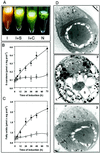Induced beta-carotene synthesis driven by triacylglycerol deposition in the unicellular alga dunaliella bardawil
- PMID: 9536040
- PMCID: PMC35030
- DOI: 10.1104/pp.116.4.1239
Induced beta-carotene synthesis driven by triacylglycerol deposition in the unicellular alga dunaliella bardawil
Abstract
Under stress conditions such as high light intensity or nutrient starvation, cells of the unicellular alga Dunaliella bardawil overproduce beta-carotene, which is accumulated in the plastids in newly formed triacylglycerol droplets. We report here that the formation of these sequestering structures and beta-carotene are interdependent. When the synthesis of triacylglycerol is blocked, the overproduction of beta-carotene is also inhibited. During overproduction of beta-carotene no up-regulation of phytoene synthase or phytoene desaturase is observed on the transcriptional or translational level, whereas at the same time acetyl-CoA carboxylase, the key regulatory enzyme of acyl lipid biosynthesis, is increased, at least in its enzymatic activity. We conclude that under normal conditions the carotenogenic pathway is not maximally active and may be appreciably stimulated in the presence of sequestering structures, creating a plastid-localized sink for the end product of the carotenoid biosynthetic pathway.
Figures






Similar articles
-
Isolation and Characterization of a Protein Associated with Carotene Globules in the Alga Dunaliella bardawil.Plant Physiol. 1995 Aug;108(4):1657-1664. doi: 10.1104/pp.108.4.1657. Plant Physiol. 1995. PMID: 12228570 Free PMC article.
-
Stereoisomers of beta-Carotene and Phytoene in the Alga Dunaliella bardawil.Plant Physiol. 1988 Apr;86(4):1286-91. doi: 10.1104/pp.86.4.1286. Plant Physiol. 1988. PMID: 16666068 Free PMC article.
-
Novel 9-cis/all-trans β-carotene isomerases from plastidic oil bodies in Dunaliella bardawil catalyze the conversion of all-trans to 9-cis β-carotene.Plant Cell Rep. 2017 Jun;36(6):807-814. doi: 10.1007/s00299-017-2110-7. Epub 2017 Mar 11. Plant Cell Rep. 2017. PMID: 28285407
-
A hypothesis about the origin of carotenoid lipid droplets in the green algae Dunaliella and Haematococcus.Planta. 2019 Jan;249(1):31-47. doi: 10.1007/s00425-018-3050-3. Epub 2018 Nov 23. Planta. 2019. PMID: 30470898 Review.
-
Biosynthesis and regulation of carotenoids in Dunaliella: progresses and prospects.Biotechnol Adv. 2008 Jul-Aug;26(4):352-60. doi: 10.1016/j.biotechadv.2008.03.004. Epub 2008 Apr 7. Biotechnol Adv. 2008. PMID: 18486405 Review.
Cited by
-
Production of carotenoids by microalgae: achievements and challenges.Photosynth Res. 2015 Sep;125(3):423-36. doi: 10.1007/s11120-015-0149-2. Epub 2015 Apr 29. Photosynth Res. 2015. PMID: 25921207 Review.
-
Synthetic biology and metabolic engineering for marine carotenoids: new opportunities and future prospects.Mar Drugs. 2014 Sep 17;12(9):4810-32. doi: 10.3390/md12094810. Mar Drugs. 2014. PMID: 25233369 Free PMC article. Review.
-
Stress-induced changes in optical properties, pigment and fatty acid content of Nannochloropsis sp.: implications for non-destructive assay of total fatty acids.Mar Biotechnol (NY). 2011 Jun;13(3):527-35. doi: 10.1007/s10126-010-9323-x. Epub 2010 Sep 30. Mar Biotechnol (NY). 2011. PMID: 20882331
-
Reduction of fatty acid flux results in enhancement of astaxanthin synthesis in a mutant strain of Phaffia rhodozyma.J Ind Microbiol Biotechnol. 2010 Jun;37(6):595-602. doi: 10.1007/s10295-010-0706-9. Epub 2010 Mar 15. J Ind Microbiol Biotechnol. 2010. PMID: 20229332
-
Hypoosmotic expression of Dunaliella bardawil ζ-carotene desaturase is attributed to a hypoosmolarity-responsive element different from other key carotenogenic genes.Plant Physiol. 2014 May;165(1):359-72. doi: 10.1104/pp.114.235390. Epub 2014 Mar 14. Plant Physiol. 2014. PMID: 24632600 Free PMC article.
References
-
- Al-Babili S, v Lintig J, Haubruck H, Beyer P (1996) A novel, soluble form of phytoene desaturase from Narcissus pseudonarcissus chromoplasts is hsp70-complexed and competent for flavinylation, membrane association and enzymatic activation. Plant J 9: 601–612 - PubMed
-
- Bejarano ER, Parra F, Murillo FJ, Cerdá-Olmedo E. End-product regulation of carotenogenesis in Phycomyces. Arch Microbiol. 1988;150:209–214.
-
- Ben Amotz A. Adaptation of the unicellular alga Dunaliella parva to saline environment. J Phycol. 1975;11:50–54.
LinkOut - more resources
Full Text Sources

